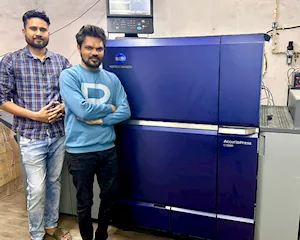Editorial: Celebrate print, issue a subpoena to bad news
If Indian participation to the London Book Fair was crippled by the volcano ash, Ipex 2010 saw 50% of Indians unable to attend due to an Indian malaise - not applying for a UK visa in time.
16 Jun 2010 | By Samir Lukka
On cue, all the nay sayers started to ask: Will printing survive? Will this be the last Ipex at Birmingham?
Meanwhile, I watch the news in Karur (no passport or visa to travel into the heartland of Tamil Nadu), that Apple has shot past Microsoft to become the world's most valuable technology company. The changing of the guard caps one of the most stunning turnarounds in business history for Apple, which had been given up for dead, a decade earlier.
While Apple is basking in glory, Sony has launched an e-reader thereby taking on Apple's iPad. The e-book space is expected to double to $1 billion in four years. But what grabs one's eyes is, a small footnote which says, Sony will partner with printing firm Toppan Printing and the Asahi Shimbun newspaper to set up a planning company to prepare for a service which will offer book, comic, magazine and newspaper content.
Print is striking back, in an unexpected way.
Karur which is where I am writing this editorial, is the base for TNPL, producers of printing and writing paper, which intends to up production to four lakh tonnes with its expansion program. Seshasayee has revived its Rs 250-crore expansion plan in nearby Erode; and West Coast hopes to up its paper production capacity by 3.2-lakh tonnes per annum. And AP Paper Mills (APPM), one of India's largest pulp and paper producers has begun production in Rajahmundry.
Some hope on the paper front, it seems.
Meanwhile IT company CMS has diversified into printing billion documents per year. For this, CMS, will install VDP and post-print solutuions at India Post premises and later in government organisations like LIC.
Print is definitely striking back.
I travel to Sivakasi - and the news from the Indian book printing giants - Srinivas Fine Arts, Lovely Offset and Gopsons is astounding. The good news is, there's space for hundreds of book printing plants.
(Ramu Ramanathan is editor of PrintWeek India)
Mantras from Printer’s Devil
Some printers in India have discarded the CMYK colour model. They print four-colour jobs with three inks: cyan, magenta and yellow.
- Some printers in South India have decided to dispense with the key black ink. This means, they print a four-colour job with three colours, CMY.
- These printers say: black is an inauspicious colour and to deploy blank ink for wedding cards and invitation cards is equivalent to inviting bad luck.
- So? How is the black generated? This is rendered by mixing cyan, magenta and yellow inks. Naturally, print results are unsatisfactory. The reason: a combination of 100% cyan, magenta, and yellow inks results in a muddy dark brown colour that does not appear black.
- Traditionally text is printed in black and includes fine detail (such as serifs). This means, to reproduce text or detailed outlines using three inks on a single colour press – without blurring – would require impractically accurate registration.
- A combination of 100% cyan, magenta, and yellow inks soaks the paper with ink, making it slower to dry. This can cause the ink to bleed, which means it spreads to undesired areas.
- And yet these three-colour jobs continue to be produced. And tradition continues to triumph over matters of print science.
If you’ve a print story to share, an incident that made you smile or an usual occurence on the shopfloor, email it to samir@haymarket.co.in














 See All
See All